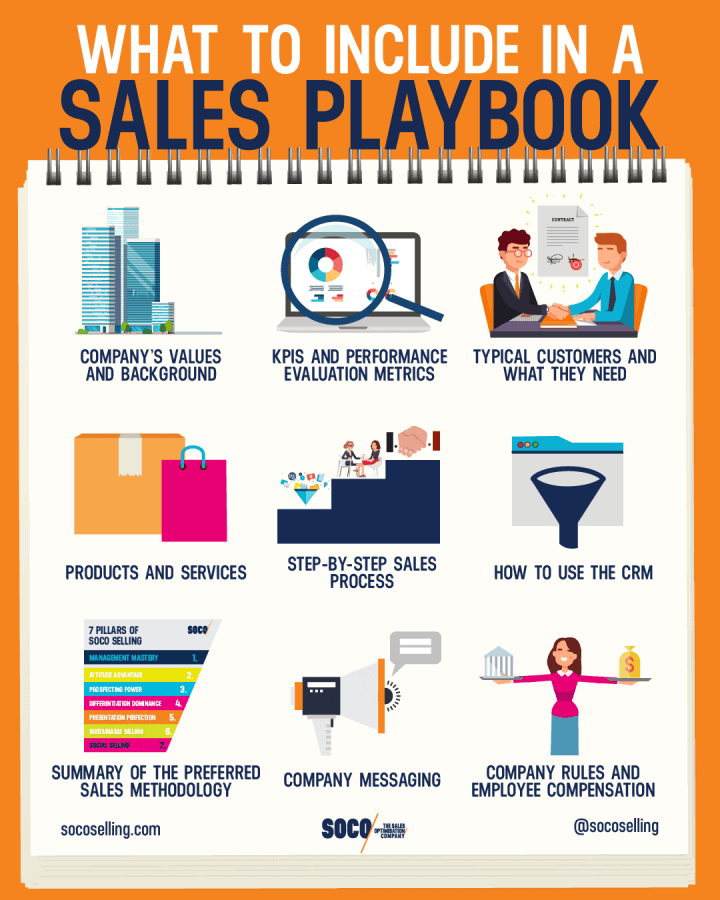Is your company’s sales team equipped with a comprehensive sales playbook? If not, you might inadvertently be impeding the progress of the freshly integrated sales force you are currently bringing on board.
By implementing a sales playbook, you are essentially formulating the definitive guide to achieve sales triumph for your sales team.
This sales playbook serves as a navigational tool, offering new team members an in-depth understanding of the company’s protocols, the intricacies of its sales procedures, and the optimal approaches and sales process endorsed by your organization.
In the following discourse, we will elucidate the concept of a sales playbook and outline the essential components that yours should encompass.
This will empower you to develop a potent sales playbook for your sales team right from the outset, ensuring a seamless integration process.
Let’s begin!
Table of Contents
What Is a Sales Playbook?
A sales playbook offers a rundown of everything your sales team must know and do to close deals and make sales. For example, you’ll go over your internal company organization, what you sell, and how you price your products and services, among other things.

Although sales playbooks do not replace the hands-on instructional training that new salespeople receive before they join your team, the sales playbook can augment that training.
It’s a reference guide that your sales team can look at whenever they have a question or need information on something related to sales.
Of course, they’re still free to get in touch with a member of your business, but most of the information they need is right there in the sales playbook.
This allows the sales rep to resolve their own issues faster and with the involvement of fewer parties so they can get right back to closing that latest deal.
What Goes Into a Sales Playbook?
A sales playbook is chock full of valuable information from the first page to the last. In this section, let’s take a closer look at everything that must go into your first sales playbook to make it awesome.
1. Information on your business
What is your business about? We mean more than the blurb on your LinkedIn page or website homepage. You want to present clear, concise information in this first section of the playbook.
For instance, it helps to add an organizational chart that lays out each member of your startup as well as their job titles and responsibilities.
You might not have a big sales team yet, but that’s changing all the time. Make sure you continually update the chart.

You should also use this section to outline your business strategy.
What does the big picture look like for your company? Why did you create the company in the first place? What are you hoping to achieve with it?
This blends nicely into a review of your values, complete with a mission statement.
The data in this first section offers your new salesperson information about your business they might not have known about.
They’ll also understand the values that your company tries to portray so they too can perform by those values.
Read also: Customer Intelligence (CI): The Missing Support Puzzle Piece
2. The training process and job responsibilities
Next, it’s time to delve into what the training process will look like.
Exactly how long will you train the new sales rep? What will their training entail? What should they expect to know by the time the training wraps up?
You also want to add the sale rep’s job responsibilities to this section of the sales playbook.
Be clear on every responsibility so the rep doesn’t feel like they have to guess whether they should do something or if it’s outside of their wheelhouse.
Read also: 12 Powerful Sales Growth Strategies (+ Calculations)
3. An overview of your products and services
Your sales rep needs to know what they’re going to be selling, and that’s what this section is for.
Assume the sales rep knows nothing about your current products and services, so explain it to them as you would to a complete beginner.
Go over each product or service in the roster, what it does, and how it works.
Discuss which specific needs the product or service fulfills and why customers care.

4. Your pricing and commission structures
How much do your products and services cost? This is huge information that every sales rep must be equipped with, so don’t forget to add it to your sales playbook!
If your business offers sales commissions, you also want to include an overview of that in the sales playbook as well.
How does the commission structure work? Does the sale rep earn base pay plus commission and a bonus or only their salary?
What quota percentage must they achieve to maximize their commission?
When explaining the commission structure, be sure to include lots of examples for clarity.
Read also: 8 SMART Sales Goals for Business Growth [+ Case Study]
5. Your sales processes and methodologies
Now it’s time to delve into how your sales team sells.
Although this information might seem obvious, it isn’t, so include it in your sales playbook.
Your sales methodology entails the best practices and principles that drive your sales team.
In other words, it includes the dos and don’ts so your new sales rep can retain current customers and smoothly convert leads.
You also want to explain your sales processes, of which there are all sorts of various models.

If you use a preexisting model or even your own unique model, you need to elaborate on the sales process from the start of the sales funnel to the end.
Add your sales plays as well, including the processes for qualifying leads, choosing your sales cadence, and forecasting leads.
Our best advice? Be as thorough as this section of your sales playbook requires. You don’t want to leave any stone unturned.
This section will be the bulk of your sales playbook, and rightfully so.
Read also: The Top 10 Sales Intelligence Tools and What They Do Best
6. Your target audience
Your new sales reps must know who they’re selling to, which means a section dedicated to your target audience.
You want to include information like the target audience’s goals, motivations, pain points, job title, location, industry, company size, and who makes the decisions.
The best way to present this information so that it’s easy to understand for your sales reps is to showcase all your buyer personas or customer avatars in the sales playbook.
Each avatar will have its own unique set of needs and pain points.
When your sales reps know what kinds of customers they’re likely to deal with, they can anticipate needs, come up with targeted products, and easily deal with objections even if they’re brand new to the job and your customer base.

7. Time management techniques
Time is money, so you want to ensure your sales reps are spending their time wisely.
You should include a sample schedule that indicates to the new hire what their own schedule might look like.
Be clear that they needn’t mimic this schedule down to the second but simply use it as inspiration when determining how to structure their own day.
Read also: The 10 Best Sales Books (That Aren’t About Manipulation and Bull****)
8. The sales tools your business uses
Even the best sales reps rely on sales tools, and your new hire will be no different.
In this next section of the sales playbook, you should detail the sales tools your company uses and how each works.
Of course, even an overview of your sales tools can never replace a good, old-fashioned experience. Allow your new sales reps adequate time to sample each sales tool.
Read also: How to Pitch Your SMB Sales Like a Pro
9. Metrics your business tracks
All businesses rely on key performance indicators or KPIs to gauge how well an employee is doing. In the sales department, it’s no different.
You want to mention to your new hire all the metrics you’ll review pertaining to their performance, from deals closed to the number of leads acquired, percentage of quota reached, and profits made.
You should also explain where this information is located in the sales dashboard and how you measure it.

10. Internal and external resources for further information
Finally, your sales playbook should include resources for the new hire. This will be a combination of internal and external company information that they can peruse at their leisure.
Be sure to add pertinent articles, training materials, pitch decks, battle cards, sales dialogues, presentations, sales sheets, case studies, and whitepapers that gear them up to be more efficient at their job.
Read also: MEDDIC Sales Methodology: What Is It and Why You Need It
Conclusion
The sales playbook serves as an informative manual designed specifically for incoming sales recruits, furnishing them with comprehensive insights into their anticipated job responsibilities, sales strategy, and the methodologies by which these tasks should be executed.
Having familiarized yourself with the diverse elements constituting an effective sales playbook, you are now poised to craft your own personalized version, expediting the journey to achievement for your recently onboarded sales representatives.
But before we part ways, why not take the opportunity to explore a rising star among sales tools?
It’s garnered acclaim from none other than GetApp, solidifying its status as a favored choice in the realm of emerging sales solutions!
EngageBay offers a ton of sales automation features, and costs only a tiny fraction of what you’d pay for popular tools like Salesforce.


